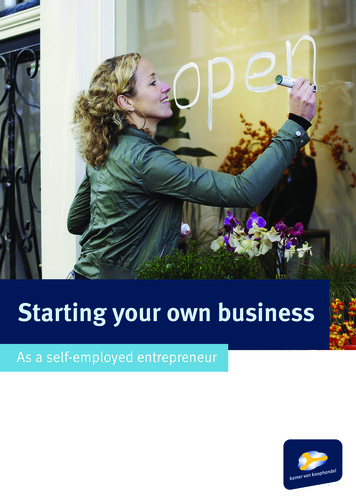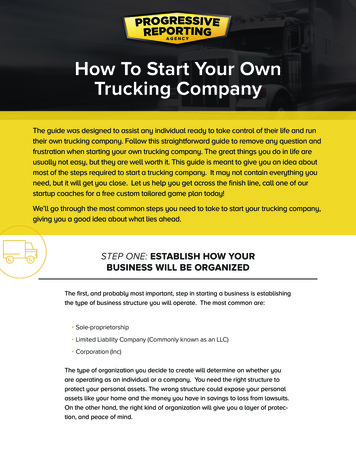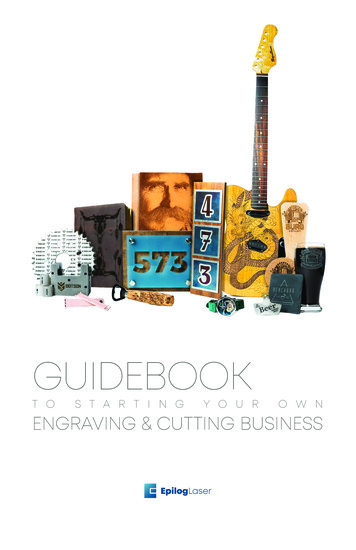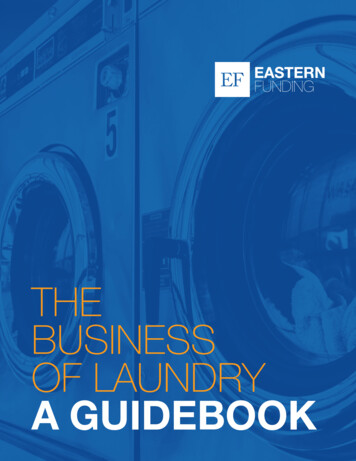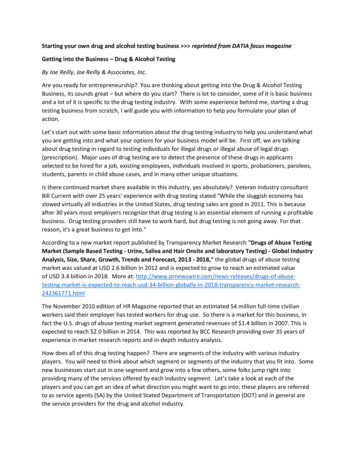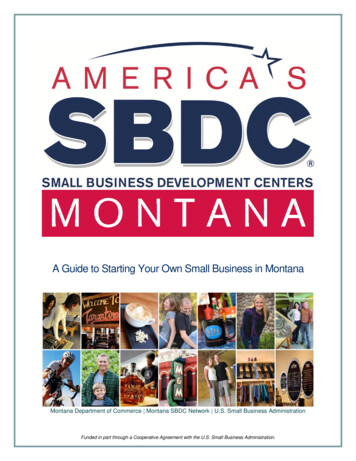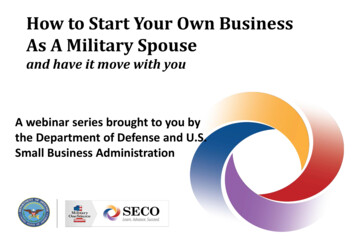
Transcription
How to Start Your Own BusinessAs A Military Spouseand have it move with youA webinar series brought to you bythe Department of Defense and U.S.Small Business Administration
How to Finance Your BusinessRay MilanoU.S. Small Business AdministrationOffice of Veterans Business DevelopmentCosponsorship Authorization # 15-6010-44. SBA’s participation in this cosponsored activity is not an endorsement of the views, opinions, products or services of any cosponsor or other person or entity. All SBAprograms and services are extended to the public on a nondiscriminatory basis.-2
Getting Set Among the topics to be covered are: Possible sources of business funding What lenders look for in a loan applicant (the “FiveC’s of Credit”) What a credit score is and why it matters What’s included in a loan application, including theimportance of a Business Plan and cash flowprojections and assumptions, AND Avoiding predatory lending practices3
Getting Set:Where do you start?You learned the basics about setting up yourbusiness during the Ready module and nowyou’re Set to get started, but you need moneyso that you will be ready to “Go” . . .4
Getting Set:Where to Get Money to Start a Business Money that you have savedMoney from an investor who gets a share/piece of yourbusiness Money given or loaned to you by your family or friends Money that you borrow personally – usually through a homeequity line of credit or a credit card Money that you borrow through a business loan Microloan lending program State or other local lending program Business loan from a bank or other lender including a loansupported by Small Business Administration (SBA)5
Financing Resources Personal Savings Family & Friends Private Lenders Private Investors Seller Financing Supplier Financing Leasing Landlord Concessions Online Lenders Peer to Peer Lending Home Equity LoansGovernment Agency Loansand GrantsRegional EconomicDevelopment AgenciesPrivate Agency LoansFinance CompaniesCrowdfundingCredit Cards *
7
Getting Set:Getting a Business LoanWhat does a small business ownerneed to do to get a bank or otherlender to say “YES” to a loanrequest?Where do you start?8
Getting SetIntroduce Your Business to a LenderThe first step is to open a businesschecking account Talk to the bank officerabout your business Ask about loans the bankmay provideRemember: The only thing a potential lender knowsabout your business is the story that you tell.9
Getting SetWhat you Need to Know about Traditional Lenders Everyone has heard jokes about cold-heartedbankers BUT . . . The truth is that lenders exist to lend – they wantto make loans BUT Most banks also must answer to the bank’s ownersAND to the agencies that regulate them – so, theybalance credit risk against bank profit Conventional vs SBA Loans10
Why Do Lenders Use the SBA Guaranty? Longer maturities are needed Collateral may be inadequate to meet normal underwritingStart-up or certain types of businessesMinimize risk
7a Loan ProgramMade by private lenders, with SBA guarantee - SBA helps thebank get to the YES decision with credit enhancement. Maximum loan size 5 million 85% guarantee for loans less than 150,00075% guarantee for loans over 150,000 up to max
504 Loan Program Long-term financing for real estate & major fixed assetsUp to 5.5 million in SBA-backeddebenturesCommercial lender & SBA approvedcertified development company
Typical 504 Program ProjectThe ProjectLenderCDCCompanyCoversUp To 50%Covers Up To 40%SBA Guaranteed DebentureAt least 10%Equity required
Veterans Advantage &Veterans Entrepreneurship Act of 2015 SBA Express Loan Program (VE Act of 2015) 50% GuarantyNo Guaranty Fee for loans up to 350K Guaranty Fee reduced by 50% for all 7a loans(except SBA Express) 150,001K – 5 Million(Veterans Advantage)Eligibility VeteransActive Duty service members eligible for TAPReservists and National Guard MembersCurrent Spouse of any of the aboveWidowed Spouses (Death during service orservice connected)
Getting SetWhat You Need to Know aboutNon-Traditional LendersLoan sources OTHER than banks, include: Credit UnionsMicrolendersCommunity-based lending programsCommunity Advantage lenders that make loans undera special SBA business loan program Online lending platforms16
Community Advantage Loan ProgramCommunity Advantage is a pilot initiative aimed at increasing the number of SBA 7(a) lenderswho reach underserved communities, targeting community-based, mission-focused financialinstitutions which were previously not able to offer SBA loans.Maximum Loan Size: 250,000Guarantee: 85 percent for loans up to 150,000 and 75 percent for those greater than 150,000.Approval Times: Most Community Advantage loans will be approved within 5 to 10 days.Paperwork: Community Advantage features streamlined paperwork, with a two-pageapplication for borrowers.Lender Requirements: Community Advantage is open to mission-focused lenders, includingCommunity Development Financial Institutions, SBA’s Certified Development Companies andSBA’s nonprofit microlending intermediaries. Community Advantage lenders will be expected tomaintain at least 60 percent of their SBA loan portfolio in underserved markets.
Getting SetWhat is a Microloan?A microloan is typically offered to businesses with smallerstart-up capital needs, usually less than 50,000Advantages of microloans – typically from microlenders Have more flexible credit requirements Pay more attention to the character of the business owners Work more closely with their borrowers May provide technical help and advice to borrowers Understand the conditions in the local community and howthat may affect businesses operating there18
Getting SetMore on MicroloansSBA’s microloan program relies on community-basedorganizations to provide small loans to people who want tostart or grow their small businesses Maximum loan size is 50,000 – average loan size 13,000 Loan funds can be used for working capital, inventory, supplies, equipment, furniture, etc., but NOT for real estate or to repayexisting loansLoan requirements vary from lender to lendermicrolenders also provide help to borrowers with business basicsand any problems that come up after the loan is madeNon-SBA microloan programs alsomay be available in your community19
Getting SetWhat Matters Most to LendersNo matter who you ask to lend you money, the lender will belooking for-- A business owner who knows the business, has the abilityto run it well, and is willing to work hard to make it succeed A business that is financially sound or, if it is brand new,appears to have the ability to make enough money to payits bills, give its owner an income and pay back the loan Collateral to cover at least part of their lending riskAn investment from the business owner – usually thebusiness owner’s own money that gets put into the businessto pay for some of the things that it needs20
Getting SetWhat Lenders Are Looking ForIn short: Lenders look for an applicant thatthoroughly addresses what are commonly knownas the five C’s of CreditCCCREDITCCC21
Getting SetUnderstand 5 C’s of CreditCCharacterCCapacity / Cash FlowCCollateral (Guarantees)CCapital / ContributionCCondition22
Getting Set1st C CharacterCharacter your personal reputation and generalimpression you make on your lender; your integrityEspecially important to non-traditional lendersWhat a lender considers – Who you are Whether you have lived in your neighborhoodfor a long time or whether you have justmoved in Whether you have an account with the bankand whether you have ever had a loan from thebank or other lenderAnd . . .23
Getting Set1st C Character How you pay your bills (information reported by creditbureaus) Bad credit usually means the loan will be turned downYour references – the people you ask to vouch for yourcharacter if a lender asks This could be someone you have done business with, aformer boss, etc., anyone who can speak about yourhonesty and good business practicesYour experience in running a business (managementexperience) and experience in the type of business you arestarting24
Getting Set1st C CharacterYour Personal Credit StandingHow do you find out how you will look to a lender? Order a copy of your credithistory and FICO scoreLargest credit reportingagencies Equifax TransUnion ExperianAll are required to providea free report every year –https://www.annualcreditreport.com25
Getting Set1st C CharacterWhat if Your Credit Score is Low?Some things can be fixed . . . Review the reports for mistakes – if any mistakes are found – Contact the creditor in writing to ask to have the report fixedContact the credit bureau in writing to find out how to correct wronginformationAll three credit bureaus accept disputes submitted onlineProvide copies of your letters to your lenderIf report is correct, but negative – try to fix it before applying fora loan Make credit payments on timeReduce the amount of debt you oweIf necessary, work with a non-profit that will provide free credit counseling26
2ndCGetting SetCapacity / Cash FlowCapacity whether your business makes enoughmoney to pay all its bills including the new loan –This is the most important of the 5 C’s because itmeasures whether you can pay back the loanThe amount of money that youmake or expect to make(“cash flow”) should be sufficientto pay all expenses and allow alittle extra in case somethingunexpected comes up27
2nd CGetting SetCapacity / Cash FlowIf you are an existing business – lender will look at: How much money you have made in the past (historic cash flow) asshown in your business financial statements and tax returns – usuallylast two years plus current year to date If you are just starting your business – lender will rely on: Your Business Plan Your estimates (projections) of how much money you will make(revenues) and how much money you will need to spend (expenses)28
3rdCGetting SetCollateral / GuaranteesCollateral something of value (“tangible asset”) thatyou own or will buy with money from the loan thatyou can “pledge” to secure a loanThis may be less important to a non-traditional lenderMost lenders also require the business owners topersonally guarantee the loan a promise to repay theloan even if the business fails29
Getting Set4thCCapital / ContributionBusiness Capital business net worthWhat the business owns (assets) minus what it owes(liabilities) Includes money you have invested in the business Shows your commitment to the business and what you have at riskif the business fails A lender expects you to have contributed something to thebusiness (equity injection) – in other words, have some “skin in thegame” Especially with traditional lenders, lack of equity usually means loanwill be turned down30
Getting Set5thCConditionCondition Loan conditions that a lender considerswhen approving your loan such as : Loan amountInterest rateWhat you will use the loan for, for example, to buy fixedassets like real estate or equipment; for inventory; or forworking capital; etc.AND How well people are doing in your community and how wellyour business’ industry is doing31
Getting SetPrepare to Ask for a LoanAsking for a loan to help start or grow your business can beintimidating, but you can help your chances for success by . . . Being well-prepared – Have a thought out andwritten plan for the steps that you will take to getstarted or get through your next growth phase Telling your story well – Help your lender getexcited about your dream and believe that youwill succeedBeing very honest in your presentation of yourself and yourbusiness – lenders don’t want to just hear the good things; theywant to know about any weaknesses, too32
Getting SetPrepare to Ask for a Loanof business owners and other key managers33
Getting SetThe Basics of Your Loan Request How much money do you need? How will you use the money? Will you be buying something – real estate, equipment,etc.? OR Do you need working capital – money to help you payyour daily expenses like rent, utilities, employeesalaries, inventory, etc.34
Getting SetThe Basics of Your Loan Request What type of loan are you seeking – A term loan A fixed amount of money that you will pay backduring a specified period of time OR A line of credit Allows you to borrow up to a maximumamount of money, repay some of it and borrow more up tothe maximum loan amountExample: lines of credit are useful in retail businessesthat may need money to purchase inventory. You canrepay the borrowed money when you sell the inventory -and then you would need to borrow more to buy moreinventory35
Getting SetThe Basics of Your Loan Request HOW will you pay the money back? – How much can you afford to pay each month?(loan payment) How many months or years will you need to paythe loan back? (loan maturity) Do you own anything of value such as real estate,(collateral) that you can pledge to the lender tosupport a loan? How much is what you ownworth?36
Getting SetThe Basics of Your Loan Request What is your company’s financial condition? Can you pay all of your bills everymonth? Are you paying your bills on time? Do you ever write checks for morethan you have in your checkingaccount?37
Getting SetHow Much Should You Ask For? How much money does your business really need? –now and over the next few months (short-term needs)and the next few years (long-term needs) Hard question that only you can answer – and seekhelp from technical assistance resources in yourcommunity If business is just getting started, you need to considerall business needs during the start up periodLoan request cash needed minus the money that youhave to put into the business (your equity contribution)38
Getting SetYour Business PlanOne of the Most Critical Documents in Loan ApplicationHelps you to think about all of the details of how your businesswill operate. Serves as an action plan to manage, organize and sustain Helps identify and define your target market Helps plan and anticipate future capital needs Demonstrates how you will make money Tells the story of your business to others includingpotential lendersBusiness plan templates are available from a variety of sourcesincluding SBA: https://www.sba.gov/tools/business-plan39
Getting SetFind Help to PrepareYour Business PlanEntrepreneurship is a Team Sport SBA’s Resource Partners – SCORE mentors Small Business Development Centers Women’s Business Centers Veterans Business Outreach Centers Local chambers of commerce Local colleges and universities Accountants Business consultants40
Getting SetFinancial InformationWhat do you need?Balance SheetIncome StatementFiled Tax returnsProjections andAssumptions How far back do you need to go?Typically a minimum of 2 years – 3 years for SBA Can you put this together on your own? Possibly, but this is where expert assistance is reallyimportant If you receive assistance with your projections, make surethat YOU understand and agree with them and can explainthem to a lender41
Getting SetPreparing Financial Reports Having good financial systems is critical to ensure that – All taxes are paid as required and Lenders know what they need to know about your businessoperationsAccounting and bookkeeping software is available to help youset up your financial records and record your income andexpenses on a regular basisAssuming that your historical data is in order, the next mostcritical information – whether new or existing business – is yourcash flow projections and assumptions42
Getting SetPreparing Financial ReportsCash flow projection estimate of money coming in andmoney going out of your business and the earnings andthe paymentsProjections should: Reflect how the loan will impact business eitherthrough purchase of additional assets, expansion offacilities/capacity, or other loan purpose Be reasonable and include explanations (assumptions) Reflect industry data to help assure that projectionsmake sense and can be verified by lenders43
Getting SetBeware of Unfair Lending PracticesA final caution . . . Not all lenders operate fairly Protect yourself by learning how to recognize unfairpractices Watch out for the following – Receiving a loan offer that you did not apply for A lender who promises you loan approval no matterwhat your credit history or credit score Being rushed to sign papers High interest rates and fees44
Getting SetBeware of Unfair Lending Practices Loan Repayment Terms that do not seem fair orappropriate, including balloon payments,penalties for early repayment, etc. Blank Spaces in Documents Do not sign any documents that contain blank spacesIf you have doubts, do not sign anything untilyou have consulted with a lawyer or trustedfriend and fully understand the terms andconditions of the loan you are being offered45
Getting SetTips for Achieving Credit-Readiness THINK LIKE A LENDER – if it was your moneygoing to support someone else’s dream, whatwould you want to know? Good preparation is key – you should be ableto answer (almost) any question your lenderasks You MUST know your business plan andfinancial data – never rely on someone else tospeak for you46
Getting SetTips for Achieving Credit-Readiness Full disclosure is required – address anysituations in your business that may appear tobe a weakness before the lender raises it Make sure that you have a good story to tellabout your business and then tell it withenthusiasm47
YOU ARE SET! You know how to get SET to applyfor a loan, what a lender looks forin a loan application and what youneed to provide You know the 5 C’s of Credit andwhy they are important You know about a creditscore and how to obtaina copy of yours You know what to avoidwhen you review a loan offer48
Ray MilanoSBA Office of Veterans Business DevelopmentEmail: raymond.milano@sba.govPhone: ip Authorization # 15-6010-44. SBA’s participation in this cosponsored activity is not an endorsement of the views, opinions, products or services of any cosponsor or other person or entity. All SBAprograms and services are extended to the public on a nondiscriminatory basis.-49
Questions? Feedback?We’d like to hear from you.Join our next l/Content/View/2791Connect with itary-Spouse-Employment-Partnership-MSEP4159976
How to Start Your Own Business As A Military Spouse and have it move with you A webinar series brought to you by the Department of Defense and U.S. Small Business Administration . Cosponsorship Authorization # 15-6010-44. SA’s participation in this cosponsored activity is not an endorsemen


